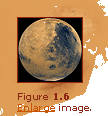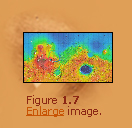|
|

Landforms
|
From Earth-based observations, Mars appears as a red planet. It
is the iron-oxide that gives the planet its reddish appearance.
In other words, Mars is a rusty planet. Like the Moon and Mercury,
there are both light-colored and dark-colored areas on Mars as shown
in Figure 1.6. After all the flyby and orbital missions of NASA,
a complete global coverage of Martian surface has become available.
It is now clear that the light-colored areas represent the heavily
cratered highlands, whereas the dark areas are the relatively smooth
lowlands. One striking feature, however, is that the light and dark
areas take on a hemispheric distribution. If the highlands are considered
the equivalent of continents on Earth, and the lowlands are the
equivalent of ocean floors, one hemisphere of the Martian surface
would become a continent and the other hemisphere would be covered
with an ocean. This is a very interesting feature, considering that
two hundred million years ago, there was also only one super-continent
and one giant ocean on Earth.
|
 |
 |
 |
 |
At present, no good explanation exists to account for the hemispheric
distribution of these two distinct landforms. The Mars Global Surveyor
was able to complete a global topographic mapping using altimetry
measurements in 1999. A detailed surface topography map is given
in Figure 1.7. In this map, the areas with the warm colors (i.e.,
red, orange, and yellow) are the heavily cratered southern highlands
and the areas with cool colors (i.e., blue and green) are the lowlands.
Both Viking landers landed on the smooth northern hemisphere.
|
The southern highland of Mars is somewhat similar to the heavily cratered
terrain of Mercury or the highlands on the Moon, where craters of all
sizes and shapes dominate the landscape. Most of this highland area, except
some interior basin floors, are, on average, more than 1 km above
the mean radius of the planet. There are also a few shield volcanos that
can be found in the southern highland. In addition, this ancient battered
surface has some large channels that appear to have been carved by rivers
or huge floods. These flow
channels give the Martian surface a decidedly different appearance
from that of the Moon or Mercury.
< back
1 2
3 4
5 6
7 next
> |



